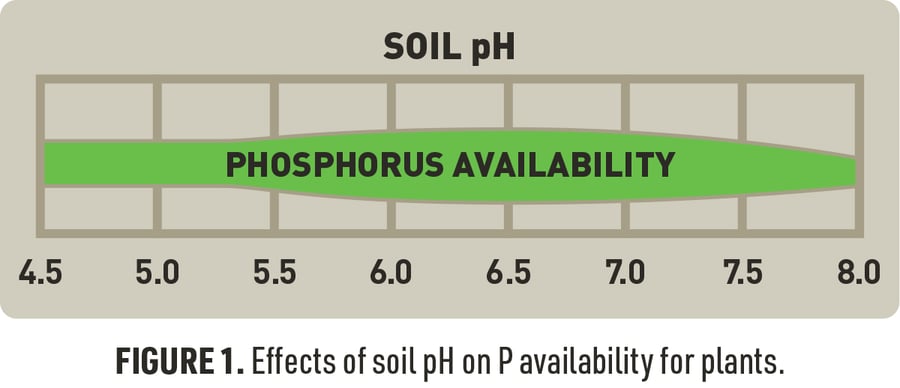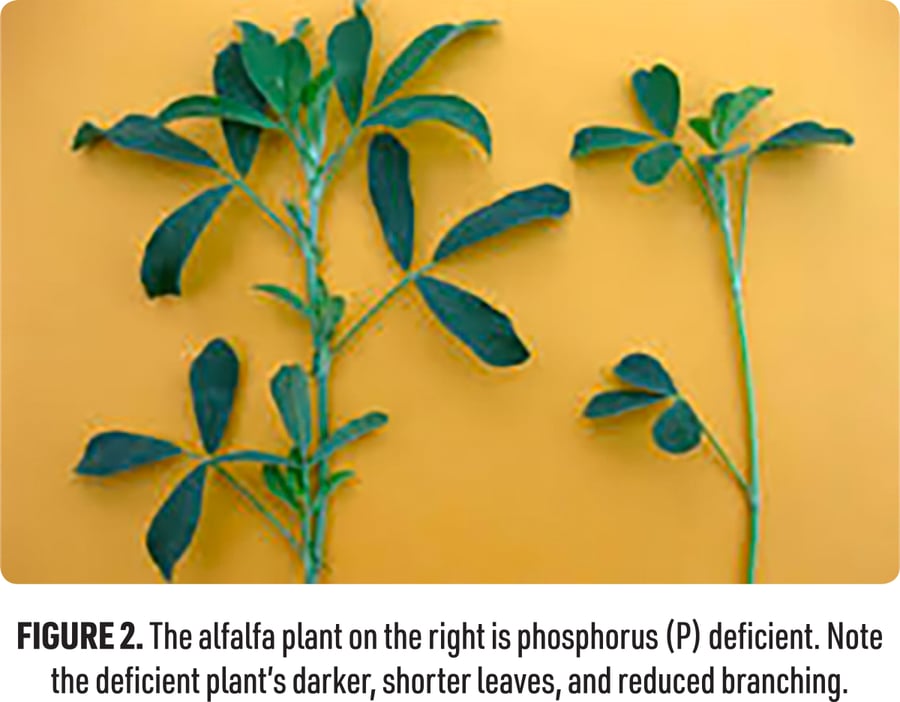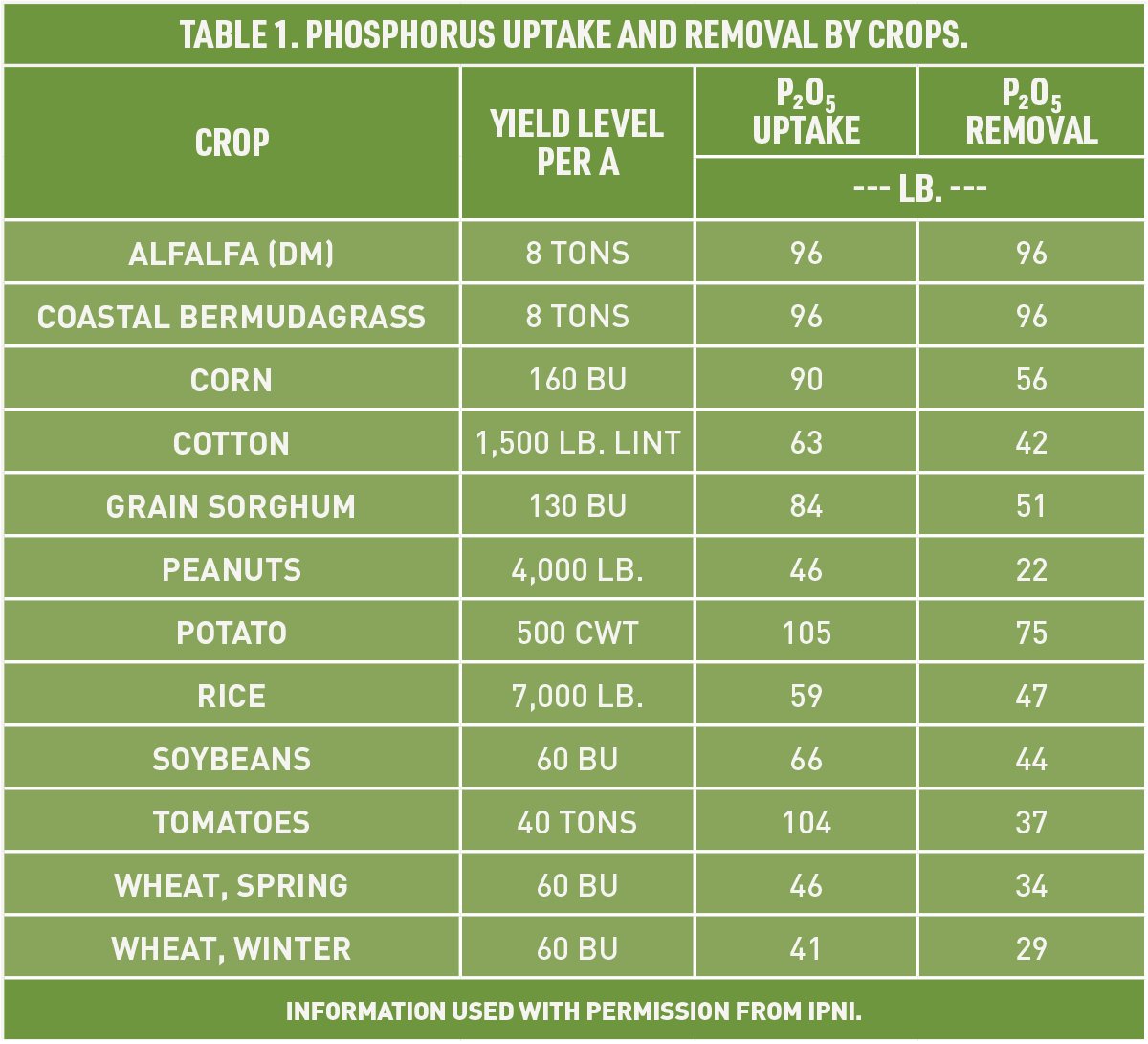
Phosphorus (P) is present in every living cell, both plant and animal. No other nutrient can be substituted for it when it is lacking.
Phosphorus is one of the 17 essential nutrients that plants need for growth and reproduction, and is considered one of the three major nutrients along with nitrogen (N) and potassium (K). They are termed major nutrients because of the relatively large amounts utilized by plants (Table 1) and the frequency with which their deficiencies limit plant growth.
Phosphorus must be added to the soil when the native supply is too low to support healthy crop growth. Maintaining an adequate supply of phosphorus is essential for plant health and high yields.
Phosphorus in Plants
Phosphorus is a vital component in the process of plants converting the sun’s energy into food, fiber and oil. Phosphorus plays a key role in photosynthesis, the metabolism of sugars, energy storage and transfer, cell division, cell enlargement and transfer of genetic information.
Phosphorus promotes healthy root growth, promotes early shoot growth, speeds ground cover for erosion protection, enhances the quality of fruit, vegetable and grain crops, and is vital to seed formation.
Adequate phosphorus increases plant water use efficiency, improves the efficiency of other nutrients such as nitrogen, contributes to disease resistance in some plants, helps plants cope with cold temperatures and moisture stress, hastens plant maturity and protects the environment through better plant growth.
Phosphorus in Soils
Plant roots can only acquire phosphorus from the soil when it is dissolved in soil water. Since only very low concentrations of phosphorus are present in the soil water, it must be continually replenished from soil minerals and organic matter to replace the phosphorus taken up by plants.
Phosphorus present in soil organic matter is not available for plant uptake until soil microbes convert the organic compounds into simple inorganic phosphate. Plant roots generally absorb phosphorus as inorganic orthophosphate ions (HPO42– or H2PO4– ).

Many soil factors affect phosphorus availability to plants, including the type and amount of clay minerals, phosphorus concentration, factors affecting root activity (such as aeration and compaction), soil moisture content, temperature, adequate supply of other essential plant nutrients, and the root properties of the crop. Additionally, soil pH (acid or alkaline) greatly influences the availability of phosphorus to plants (Figure 1).
IFA Agronomy offers the products and services proven to help you grow the things you love
Fertilizing Soils With Phosphorus
Very few soils contain an adequate supply of all of the mineral nutrients required for unrestricted crop growth. Soil and plant analysis can be used to assess the need for additional phosphorus fertilizer.
Careful nutrient management should accompany the use of all plant nutrients, including phosphorus. Without proper management, excessively high phosphorus concentrations can sometimes lead to unwanted nutrient loss.

Phosphorus Deficiency Symptoms
The first indication of a phosphorus shortage is often a stunted plant, which is difficult to diagnose. Leaf shapes may be distorted.
With severe deficiency, dead areas may develop on leaves, fruit and stems. Older leaves are affected before younger ones because of phosphorus redistribution within the plant. Some plants, such as corn, may display a purple or reddish color on the lower leaves and stems when phosphorus is low. (Figure 2).
Summary
Key points to remember before starting any fertilization program include:
- Phosphorus and Potassium positively influence alfalfa yield and stand persistence
- Alfalfa requires balanced nutrition for high yield and persistence. Split applications of phosphorus after the first and last harvests enhance productivity and avoid luxury consumption.
- Broadcast applications of phosphorus fertilizer work well since fine roots are abundant near the soil surface
- Fertilize for high yield. Do not worry about forage quality. Higher yields will compensate for slight reductions in forage quality.
- Do not over-apply potassium and other nutrients since plants can engage in luxury consumption
Phosphorus fertilization increases yields and farmer profits in many soils around the Intermountain West. Apply generously, but stay within your nutrient plan for each field. For more help with the primary nutrient of phosphorus please contact your local IFA Crop Advisor.

Written by Brett Harman, CCA, and originally published in the IFA Cooperator magazine (vol. 83, no. 2) Summer 2017. Brett is a Certified Crop Advisor (CCA) with IFA Agronomy.

